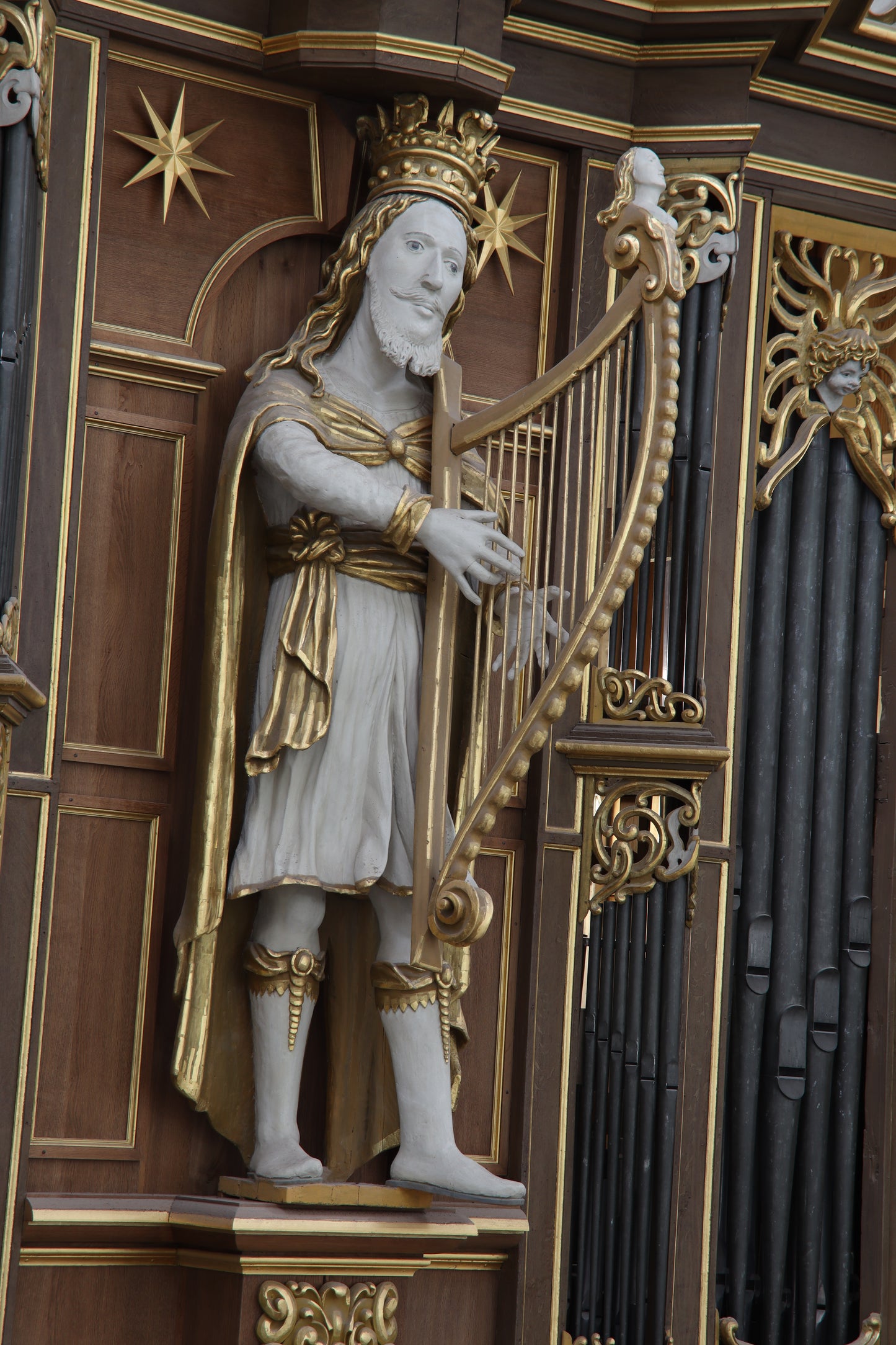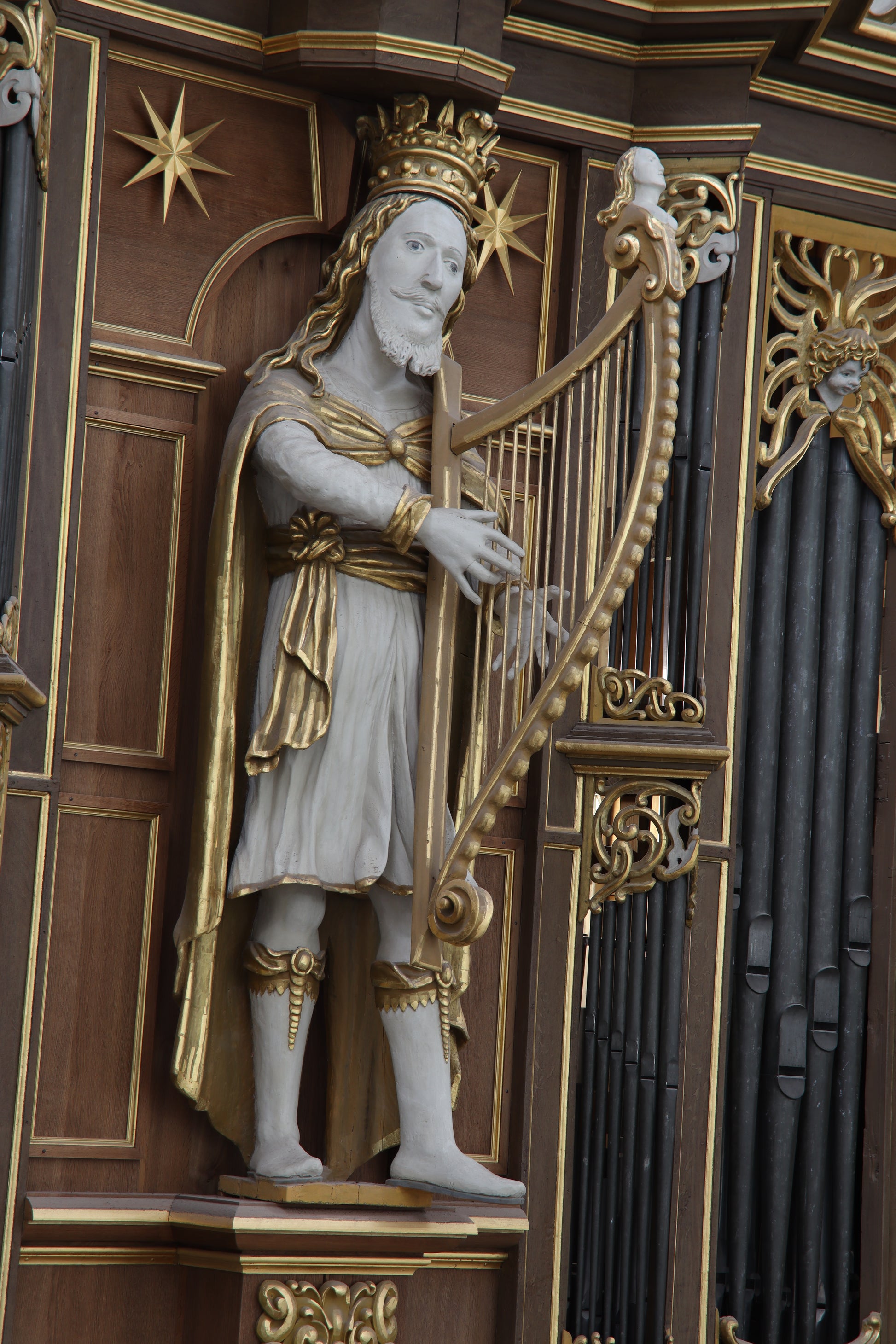1
/
of
1
Sonus Paradisi
Stellwagen organ, St. Marien, Stralsund (1659)
Stellwagen organ, St. Marien, Stralsund (1659)
Regular price
CHF 858.00
Regular price
Sale price
CHF 858.00
Unit price
/
per
Tax included.
Couldn't load pickup availability
The organ of St. Marien church in Stralsund (DE) was built by Friedrich Stellwagen (1603-1660). Today, the organbuilder is an iconic figure in German organbuilding and this organ with 51 stops on 3 manuals and a pedal is his largest preserved instrument. The organ replaced an older instrument that was destroyed by fire. During the construction of the organ, Stellwagen set up his workshop directly in the church, in the tower halls. Construction began in 1655 and was completed by October of 1659. Stellwagen died a year after that in 1660.
Numerous carved and painted figures, flames, grimaces and other elements decorate the 20-metre-high façade. In the centre stand a statue of King David playing harp, surrounded by music-making angels. The sun, moon, stars, and a winged globe crowning the organ just below the cathedral vault are also among the rich decorations. Below the case hangs an angel playing a trumpet. All these motifs went on to be characteristic of North German organ case style.
Two of the angels include the Stellwagen family coat of arms (a carriage frame) and the inscription "M. Friederich Stellwagen has performed this work. Anno 1659". On the highest crown of the façade stands an angel on a globe, holding an instrument with his right arm and a banner with the inscription "S. Dominus Deus Sabaoth" with his left arm. The central case houses the Hauptwerk and the Oberwerk. On either side are monumental pedal towers, and an equally impressive positive organ case sits in the balustrade of the organ gallery.
The organ is positioned quite high in the church, making its sound rather distant on the floor of the nave. Combined with the extreme reverberation of the building, recording this instrument was unusually challenging.
One of the most surprising features of this instrument is its very narrow scaling. The sound is clear and unusually rich in overtones. The organ was "progressive" at its time, inspired by the then-modern ideas expressed by Praetorius. For example, the Trumpet is narrow at the bottom, and wide on top, which makes the overall sound of the stop especially suitable for ensemble playing because of its good balance across the compass for polyphonic pieces. The bass is not too loud and the top is not too weak. We suspect that neo-baroque organbuilding of the second half of the 20th century took a lot of inspiration from this organ, which is why this particular instrument is so important to the history of organ building.
The instrument was changed significantly at numerous times during its history, and only a small part of the original material by Stellwagen has survived. However, Stellwagen pipes were available for many stops of the organ (550 pipes altogether). Therefore, restoration was possible, and it happened between 2004-2008 by the Wegscheider firm. When necessary, Stellwagen stops from other existing organs were studied in order to recreate stops for this monumental instrument.
Notes:
The OW Plockflött sounds at 8', according to the original contract when the organ was built. Some sources erroneously suggest this stop was a 4' stop.
The Sifflit was made a 1 1/3' stop during the restoration by Schuke (1952-1959). The Wegscheider restoration returned the stop to the original 1' pitch.
The Dultz Flött 4' is voiced to be very slowly overblowing. As the result, the stop is to be used paired with an 8' stop, it is not suitable sounding alone.
The temperament of the instrument is meantone.
Further reading:
Presented to you by Leonart Studio, your authorised reseller for Sonus Paradisi in Switzerland (shipped internationally). Get your digitally sampled historical organs for the use with the Hauptwerk virtual instrument software.
Share this Sample Set

Specification (stop list)
-
Manual I
-
Manual II
-
Manual III
-
Manual IV
-
Pedal
-
Other specification
1
/
of
6
History
Features
Requirements
This Hauptwerk Sample Set is presented to you by Leonart Studio, an authorised reseller for the manufacturer Sonus Paradisi in Switzerland (shipping internationally). Enjoy this digitally sampled organ library for the use with Hauptwerk software and start expanding your historical organ collection today.
More Hauptwerk Sample Sets
-
Schwerin, Dom, Ladegast Organ 1871 [Hauptwerk]
Vendor:Sonus ParadisiRegular price CHF 616.00Regular priceUnit price / per -
Segovia, 1772 [Hauptwerk]
Vendor:Sonus ParadisiRegular price CHF 317.90Regular priceUnit price / per -
Groningen, 1450-1740 [Hauptwerk]
Vendor:Sonus ParadisiRegular price From CHF 658.90Regular priceUnit price / perCHF 1,681.90Sale price From CHF 658.90Sale -
St. Maximin, 1775 [Hauptwerk]
Vendor:Sonus ParadisiRegular price CHF 440.00Regular priceUnit price / per -
Reuter, 1928 [Hauptwerk]
Vendor:Sonus ParadisiRegular price CHF 473.00Regular priceUnit price / per -
Casavant, 1995 [Hauptwerk]
Vendor:Sonus ParadisiRegular price CHF 174.90Regular priceUnit price / per -
Rotterdam Hoofdorgel, 1973 [Hauptwerk]
Vendor:Sonus ParadisiRegular price From CHF 330.00Regular priceUnit price / perCHF 958.10Sale price From CHF 330.00Sale -
Piacenza, 1838 [Hauptwerk]
Vendor:Sonus ParadisiRegular price CHF 330.00Regular priceUnit price / per -
Bückeburg, 1997 [Hauptwerk]
Vendor:Sonus ParadisiRegular price From CHF 1.10Regular priceUnit price / per -
Lüdingworth, 1683 [Hauptwerk]
Vendor:Sonus ParadisiRegular price CHF 330.00Regular priceUnit price / per


![Schwerin, Dom, Ladegast Organ 1871 [Hauptwerk]](http://artful.shop/cdn/shop/files/ladegast1.jpg?v=1759140126&width=533)
![Segovia, 1772 [Hauptwerk]](http://artful.shop/cdn/shop/files/ss_segovia1.jpg?v=1714213906&width=533)
![Groningen, 1450-1740 [Hauptwerk]](http://artful.shop/cdn/shop/files/ss_Groningen1.jpg?v=1693275425&width=533)
![St. Maximin, 1775 [Hauptwerk]](http://artful.shop/cdn/shop/files/ss_maximin1.jpg?v=1692902597&width=533)
![Reuter, 1928 [Hauptwerk]](http://artful.shop/cdn/shop/files/ss_Reuter1.jpg?v=1693321024&width=533)
![Casavant, 1995 [Hauptwerk]](http://artful.shop/cdn/shop/files/ss_casavant1.jpg?v=1693319885&width=533)
![Rotterdam Hoofdorgel, 1973 [Hauptwerk]](http://artful.shop/cdn/shop/files/ss_RotterdamMain1.jpg?v=1693279529&width=533)
![Piacenza, 1838 [Hauptwerk]](http://artful.shop/cdn/shop/files/ss_piacenza1.jpg?v=1693003521&width=533)
![Bückeburg, 1997 [Hauptwerk]](http://artful.shop/cdn/shop/files/ss_bueckeburg1.jpg?v=1692967628&width=533)
![Lüdingworth, 1683 [Hauptwerk]](http://artful.shop/cdn/shop/files/ss_luedingworth1.jpg?v=1692998051&width=533)